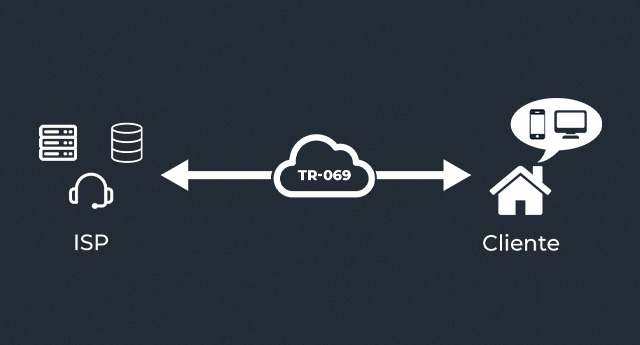Os protocolos de gerenciamento remoto como TR-069, TR-369 e TR-181 desempenham um papel vital na eficiência e estabilidade dos serviços de banda larga. Se você trabalha em um provedor de internet banda larga, provavelmente já ouviu falar destes protocolos.
Mas quais são as principais diferenças entre eles e como afetam a operação de um provedor? É o que abordaremos a seguir.
O que são TR-069, TR-369 e TR-181?
Primeiramente, vamos entender o que são esses protocolos. O TR-069 (CPE WAN Management Protocol – CWMP), TR-369 (User Services Platform – USP) e TR-181 (Device Data Model for TR-069) são especificações desenvolvidas pela Broadband Forum para gerenciamento remoto de dispositivos CPE (Customer Premises Equipment) como roteadores, modems e gateways residenciais.
As 3 principais diferenças
1. Aplicação e abordagem
O TR-069 foi criado com o propósito de gerenciamento e configuração remota dos dispositivos. Ele permite que os provedores de serviços de banda larga gerenciem e solucionem problemas nos dispositivos dos clientes de maneira remota e automatizada. A Solução Flashbox, da Anlix, utiliza a comunicação via TR-069 para que o provedor gerencie e configure remotamente as CPEs em sua rede de maneira eficiente e padronizada.
O TR-181, por outro lado, é um modelo de dados para o TR-069. Ele define uma estrutura padronizada para os dados que podem ser acessados e manipulados através do TR-069. O TR-181 não é um protocolo separado, mas sim uma extensão do TR-069, fornecendo mais detalhes sobre os dispositivos e suas funcionalidades. Ele é uma evolução do primeiro padrão de modelo de dados lançado, o TR-098.
Já o TR-369, conhecido como USP (User Services Platform), é uma evolução do TR-069. Ele oferece todas as funcionalidades do TR-069, mas vai além, permitindo o gerenciamento de uma variedade maior de dispositivos e incorporando tecnologias mais recentes como o IoT (Internet of Things).
2. Compatibilidade e escopo
O TR-069 foi projetado para funcionar com qualquer tipo de CPE que disponibilize informações utilizando os modelos de dados TR-098 ou TR-181. O modelo de dados TR-181 proporciona uma descrição mais detalhada dos dados desses dispositivos que o TR-098, permitindo um gerenciamento mais preciso.
Por outro lado, o TR-369 é mais abrangente e compatível com uma gama maior de dispositivos. Ele é capaz de gerenciar não apenas os dispositivos CPE tradicionais, mas também dispositivos IoT, tornando-o mais adaptável à crescente rede de dispositivos conectados. Ele utiliza apenas o modelo de dados TR-181.
3. Flexibilidade e Futuro
O TR-069, embora eficiente em suas funções, foi criado em uma época em que a quantidade e diversidade de dispositivos conectados era menor. O TR-369, porém, foi desenvolvido considerando a crescente popularidade e variedade de dispositivos IoT. Ele é mais flexível e está mais preparado para lidar com as demandas futuras de gerenciamento de dispositivos.
Ambos protocolos de comunicação trabalham com modelo de dados TR-181, tornando o TR-181 um padrão para troca de informações e “aposentando” o antigo formato TR-098, já anunciado pela Broadband Forum como obsoleto.
Como isso afeta a operação?

Agora, você pode estar se perguntando: como essas diferenças afetam a operação diária de um provedor de serviços de banda larga?
Em termos de funcionalidades básicas, não há muita diferença entre TR-069 e TR-369. Ambos permitem o gerenciamento remoto, a configuração e o diagnóstico dos dispositivos CPE. Portanto, no que diz respeito ao gerenciamento e resolução de problemas comuns, todos são igualmente eficientes.
No entanto, o TR-369 pode trazer vantagens no futuro, com a crescente adoção de dispositivos IoT. Se a sua empresa planeja expandir para áreas que envolvem IoT, o TR-369 poderá oferecer uma maior flexibilidade e capacidade de gerenciamento. Além disso, o TR-369 busca resolver problemas presentes no TR-069, como travessia de NAT de maneira transparente, se utilizando de outros protocolos de comunicação de informações, como MQTT e XMPP.
Conclusão
Em resumo, enquanto TR-069 e TR-369 têm suas diferenças, ambos são eficientes para o gerenciamento remoto de dispositivos CPE. As diferenças entre eles são mais relevantes em termos de compatibilidade e preparação para o futuro, em vez de impactar significativamente na operação diária. Portanto, a escolha entre eles dependerá mais da direção estratégica e das necessidades específicas de sua empresa.
Já quanto ao modelo de dados utilizado, é consenso que o TR-181 é melhor que o TR-098; mesmo a maioria das CPEs ainda suportando TR-098, a tendência é que o TR-181 venha a dominar nos próximos anos.


